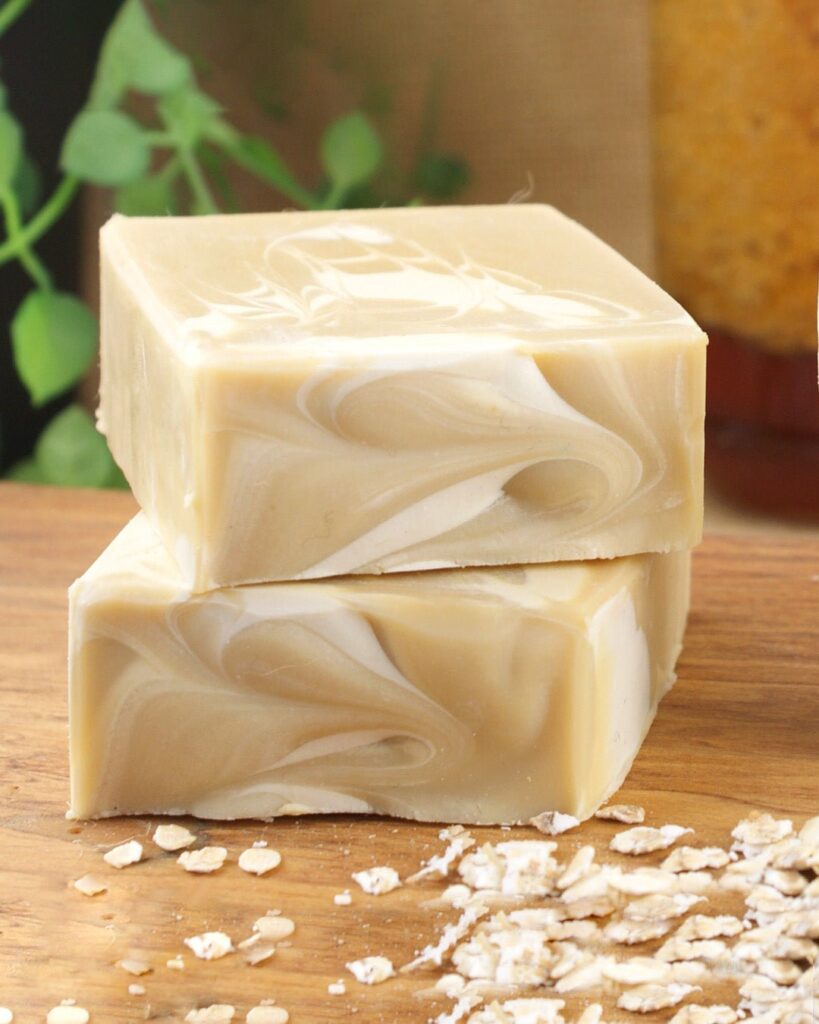
I was excited to receive my copy of Milk Soaps by Anne-Marie Faiola. I have all of her books, which I refer back to quite a lot, to come up with inspiration and soap ideas.
I love using milk in soap, but in the past I’ve only tried goat’s milk, and more recently, coconut milk. So I was happy to see a huge variety of milks in this book. It gave me some confidence to expand my milk soaping imagination!
To dip my toes into the book, I decided to try out one of the more simple recipes. It’s a Bastille soap, which means at least 80% olive oil. While this makes for a luxuriously moisturising bar, it has the trade off of being a softer soap that takes quite a bit longer to cure. So patience is key!
If you’ve never made cold process soap before, please stop now and watch these beginner soap making videos by Anne-Marie.
Once you’ve got the basics of cold process soap making down, here’s the recipe.
Ingredients
Oils
528g Pomace Olive Oil
99g Coconut Oil
33g Castor Oil
Lye Mixture
215g Almond Milk (frozen)
86g Caustic Soda (lye)
1Tbsp Sodium Lactate
Fragrance
33g Oatmeal, Milk & Honey Fragrance Oil
Colourants
2tsp Titanium Dioxide (dispersed in 1Tbsp of water)
Additives
50g Colloidal Oatmeal
1Tbsp Honey
Tools & Equipment
Wooden Loaf Mould
Mixing Jugs x3
Hanger Swirl Tool
Chopstick
Stick Blender
Spatulas
Instructions
- Add all the oils to one of the mixing jugs. Heat in the microwave until the coconut oil melts.
- In the second jug, weigh out the frozen almond milk.
- In the third jug, weigh out the caustic soda.
- Slowly add the caustic soda, one spoonful at a time, to the milk, stirring continuously until all the caustic soda has dissolved. This can take some time. Once the caustic soda has fully dissolved. Add the sodium lactate.
- When the oils have cooled to around 40C and the lye mixture is around 25C, gently pour the lye into the oils.
- Insert the stick blender and alternate pulsing and stirring until you reach emulsification.
- Add the colloidal oatmeal and honey and pulse until fully incorporated.
- Pour roughly one third of the mixture into a mixing jug and add the titanium dioxide and mix in well with the stick blender.
- Add the fragrance oil to the remaining two thirds of the mixture and stir in well.
- Pour the fragranced soap into the loaf mould, saving a little bit to add to the top of the soap at the end.
- Pour the white soap into the mould in lines up and down the length of the mould, alternating between pouring from higher up and closer to the mould. Save a little soap for the top.
- Insert the hanger swirl tool at the side of the mould and push to the bottom. Make three or four circles inside the soap while moving the tool across to the other side of the mould.
- Using the remaining soap, pour alternating lines of white and uncoloured soap along the length of the mould.
- Insert the chopstick about 1cm into the soap and swirl it from side to side to create a nice pattern on top.
Cutting and Curing
Usually I un-mould and cut my soaps within 48 hours, however because this is a bastille soap it will be very soft. I would recommend waiting at least 5-7 days before un-moulding and cutting.
Once cut, let the bars cure in a well ventilated area for at least 6-8 weeks. Although, I would recommend a minimum of 12 weeks for this bar since it’s going to be quite soft. The longer you leave it to cure, the longer it will last in the shower!
Notes
You can substitute the almond milk for any other milk you have on hand.
I used Manuka Honey, but if you don’t have access to Manuka, then any honey will be fine.
You can substitute the fragrance oil for an essential oil blend of your choice.
Some of my other favourite fragrance oils for this soap are Honey Bunny or Almond

